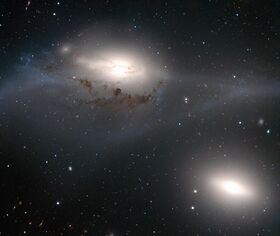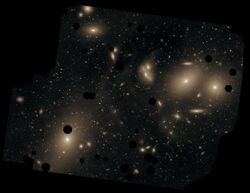Astronomy:Eyes Galaxies
| Eyes Galaxies | |
|---|---|
 NGC 4438 (top) and NGC 4435 (bottom) taken by the FORS2 instrument of the Very Large Telescope in 2011 | |
| Observation data (J2000.0 epoch) | |
| Constellation | Virgo |
| Right ascension | 12h 27m 45.6s(J2000) |
| Declination | +13° 00' 31" (J2000) |
| Redshift | 0.002638/0.000237 |
| Distance | 52 million ly |
| Apparent magnitude (V) | +10 |
| Absolute magnitude (V) | 12 |
| Characteristics | |
| Type | SB0/SA(s)O/a pec |
| Apparent size (V) | 2.35 × 1.43/8.5 × 3.2 |
| Notable features | Interacting |
| Other designations | |
| NGC 4435-8, Arp 120, VV 188 VCC 1030, VCC 1043 | |
The Eyes Galaxies (NGC 4435-NGC 4438, also known as Arp 120) are a pair of galaxies about 52 million light-years away in the constellation Virgo. The pair are members of the string of galaxies known as Markarian's Chain.
NGC 4435
NGC 4435 is a barred lenticular galaxy currently interacting with NGC 4438. Studies of the galaxy by the Spitzer Space Telescope revealed a relatively young (190 million years) stellar population within the galaxy's nucleus, which may have originated through the interaction with NGC 4438 compressing gas and dust in that region, triggering a starburst.[1] It also appears to have a long tidal tail possibly caused by the interaction;[2] however, other studies suggest the apparent tail is actually foreground galactic cirrus within the Milky Way unrelated to NGC 4435.[3]
NGC 4438
NGC 4438 is the most curious interacting galaxy in the Virgo Cluster, due to the uncertainty surrounding the energy mechanism that heats the nuclear source; this energy mechanism may be a starburst region, or a black hole-powered active galactic nucleus (AGN). Both hypotheses are currently under investigation by astronomers.
This galaxy shows a highly distorted disk, including long tidal tails due to the gravitational interactions with other galaxies in the cluster and its companion. The aforementioned features explain why sources differ as to its classification, defining it either as a lenticular or spiral galaxy. NGC 4438 also shows signs of a past, extended - but modest - starburst,[4] a considerable deficiency of neutral hydrogen, as well as a displacement of the components of its interstellar medium - atomic hydrogen, molecular hydrogen, interstellar dust, and hot gas - in the direction of NGC 4435. This observation suggests both a tidal interaction with NGC 4435 and the effects of ram-pressure stripping[5] as NGC 4438 moves at high speed through Virgo's intracluster medium, increased by the encounter between both galaxies.[6][7]
As interacting galaxies

While there is evidence to suggest that the environmental damage to the interstellar medium of NGC 4438 may have been caused by an off-center collision with NGC 4435 millions of years ago, a recent discovery of several filaments of ionized gas links NGC 4438 with the large neighboring elliptical galaxy Messier 86,[8] in addition to a discovery of gas and dust within M86 that may have been stripped from NGC 4438 during a past encounter between the two.[9][10] Given the high density of galaxies in the center of the Virgo galaxy cluster, it is possible that the three galaxies, NGC 4435, NGC 4438, and M86, have had past interactions.[11]
In popular culture
In the 2014 film Interstellar, "NGC 4438" along with specific observation data can be seen in Murphy Cooper (Jessica Chastain)'s notepad during the film's climactic sequence. As the presence of a supermassive black hole in the AGC of NGC 4438 is one of two leading theories, the galaxy is potentially that accessed by the wormhole in the film.
References
- ↑ Panuzzo, P.; Vega, O.; Bressan, A.; Buson, L. et al. (2007). "The Star Formation History of the Virgo Early-Type Galaxy NGC 4435: The Spitzer Mid-Infrared View". The Astrophysical Journal 656 (1): 206–216. doi:10.1086/510147. Bibcode: 2007ApJ...656..206P.
- ↑ The Tail of NGC 4435
- ↑ Cortese, L.; Bendo, G. J.; Isaak, K. G.; Davies, J. I. et al. (2010). "Diffuse far-infrared and ultraviolet emission in the NGC 4435/4438 system: tidal stream or Galactic cirrus?". Monthly Notices of the Royal Astronomical Society: Letters 403 (1): L26–L30. doi:10.1111/j.1745-3933.2009.00808.x. Bibcode: 2010MNRAS.403L..26C.
- ↑ Boselli, A.; Boissier, S.; Cortese, L.; Gil de Paz, A. et al. (2005). "GALEX Ultraviolet Observations of the Interacting Galaxy NGC 4438 in the Virgo Cluster". The Astrophysical Journal 623 (1): L13–L16. doi:10.1086/429377. Bibcode: 2005ApJ...623L..13B.
- ↑ Vollmer, B.; Soida, M.; Chung, A.; Chemin, L. et al. (2009). "Ram pressure stripping of the multiphase ISM in the Virgo cluster spiral galaxy NGC 4438". Astronomy & Astrophysics 496 (3): 669–675. doi:10.1051/0004-6361/200811140. Bibcode: 2009A&A...496..669V.
- ↑ "CO emission in NGC 4438 - A case for tidal stripping?". Astronomy & Astrophysics 203 (1): L9–L12. 1988. Bibcode: 1988A&A...203L...9C.
- ↑ Vollmer, B.; Braine, J.; Combes, F.; Sofue, Y. (2005). "New CO observations and simulations of the NGC 4438/NGC 4435 system. Interaction diagnostics of the Virgo cluster galaxy NGC 4438". Astronomy & Astrophysics 441 (2): 473–489. doi:10.1051/0004-6361:20041389. Bibcode: 2005A&A...441..473V.
- ↑ Kenney, Jeffrey D. P.; Tal, Tomer; Crowl, Hugh H.; Feldmeier, John et al. (2008). "A Spectacular Hα Complex in Virgo: Evidence for a Collision between M86 and NGC 4438 and Implications for the Collisional ISM Heating of Ellipticals". The Astrophysical Journal 687 (2): L69–L94. doi:10.1086/593300. Bibcode: 2008ApJ...687L..69K.
- ↑ Gomez, H. L.; Baes, M.; Cortese, L.; Smith, M. W. L. et al. (2010). "A Spectacular Hα Complex in Virgo: Evidence for a Collision between M86 and NGC 4438 and Implications for the Collisional ISM Heating of Ellipticals". Astronomy and Astrophysics 518: L45. doi:10.1051/0004-6361/201014530. L45. Bibcode: 2010A&A...518L..45G.
- ↑ "Big Galaxy Collisions Can Stunt Star Formation" (Press release). National Optical Astronomy Observatory. October 7, 2008. Archived from the original on February 9, 2013. Retrieved August 8, 2012.
- ↑ David Darling. "The Eyes (NGC 4435 and 4438)". Encyclopedia of Science. http://www.daviddarling.info/encyclopedia/E/Eyes.html.
External links
- NGC 4438
- The Eyes Galaxies on WikiSky: DSS2, SDSS, GALEX, IRAS, Hydrogen α, X-Ray, Astrophoto, Sky Map, Articles and images
Coordinates: ![]() 12h 27m 45.6s, +13° 00′ 31″
12h 27m 45.6s, +13° 00′ 31″
 |

